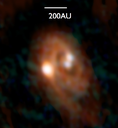Capturing Stellar Fragmentation in Disks
 Astronomers believe there are two primary pathways to form binary and multiple star systems: (a) large-scale turbulent fragmentation of cloud cores and filaments; and (b) small-scale fragmentation of a massive protostellar disk due to gravitational instability. While there is evidence for turbulent fragmentation on scales of 1000 AU, evidence for disk fragmentation is limited.
Astronomers believe there are two primary pathways to form binary and multiple star systems: (a) large-scale turbulent fragmentation of cloud cores and filaments; and (b) small-scale fragmentation of a massive protostellar disk due to gravitational instability. While there is evidence for turbulent fragmentation on scales of 1000 AU, evidence for disk fragmentation is limited.
Tobin et al. report on their study of a multiple star system, L1448 IRS3B, which is less than 150,000 years old and includes three stars, all separated by less than 200 AU. ALMA and Jansky VLA observations of the dust and molecular gas in this system reveal a disk with spiral structure surrounding the three protostars. The two protostars near the center of the disk are separated by 61 AU, and a tertiary protostar is coincident with a spiral arm in the outer disk at a separation of 183 AU. The mass of the central pair is 1 M⊙, the disk has a total mass of 0.30 M⊙, and the tertiary protostar has a minimum mass of 0.085 M⊙. The authors demonstrate that the disk around L1448 IRS3B appears susceptible to disk fragmentation at radii between 150 and 320 AU, overlapping with the location of the tertiary protostar, which is consistent with a protostellar disk that recently experienced gravitational instability, yielding one or two stellar companions.
Image: ALMA and Jansky VLA images of the gas and dust in L1448 IRS3B at 1 arcsecond resolution.
Science Team: John J. Tobin (Oklahoma, Leiden), Kaitlin M. Kratter (Arizona), Magnus V. Persson (Leiden, Onsala), Leslie W. Looney (Illinois), Michael M. Dunham (New York–Fredonia), Dominique Segura-Cox (Illinois), Zhi-Yun Li (Virginia), Claire J. Chandler (NRAO), Sarah I. Sadavoy (MPIfA), Robert J. Harris (Illinois), Carl Melis (UC–San Diego), and Laura M. Pérez (MPIfA).
Publication: A Triple Protostar System Formed via Fragmentation of a Gravitationally Unstable Disk, 2016, Nature, 538, 483.




Connect with NRAO